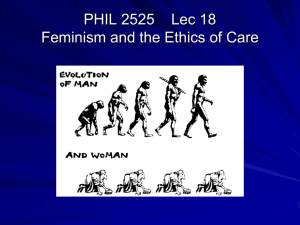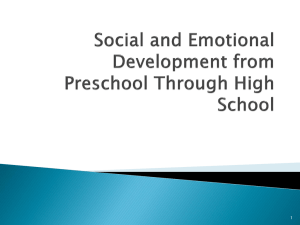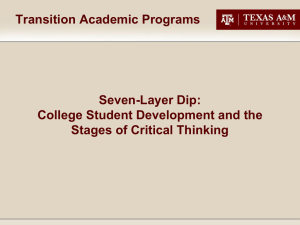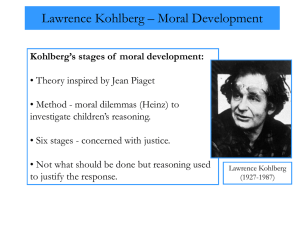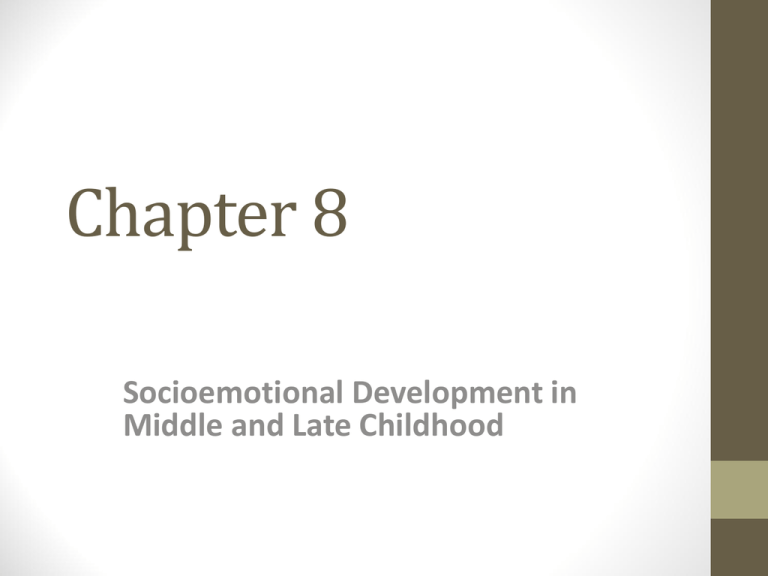
Chapter 8
Socioemotional Development in
Middle and Late Childhood
The Development of SelfUnderstanding
• Children increasingly describe themselves
with psychological characteristics and traits
• They become more likely to recognize social
aspects of the self
• More likely to distinguish themselves from
others in comparative rather than in absolute
terms
• Social comparison
• Example: “I’m a nerd…”
(Harter, 2006)
Self-Esteem and Self-Concept
• Self-esteem -- global evaluations of the
self; self-worth or self-image
• Self-esteem reflects perceptions that do not always match reality
• Self-concept -- domain-specific evaluations
of the self
• Children self-evaluate in many domains of their lives -- academic,
athletic, appearance
Social and Emotional Development
• Hierarchial structure of self-esteem
• Academic competence
• Social competence
• Physical/athletic competence
• Physical appearance
Self-Efficacy
• Self-efficacy -- belief that one can master a
situation and produce favorable outcomes
• Self-efficacy influences a student’s choice
of activities
• students with low self-efficacy for learning may avoid many
learning tasks, especially those that are challenging
• high-self-efficacy counterparts eagerly work at learning tasks
Self-Regulation
• Self-regulation -- deliberate efforts to manage
one’s behavior, emotions, and thoughts that lead
to increased social competence and
achievement
• Capacity in self-regulation is linked to
developmental advances in the brain’s prefrontal
cortex
Erikson’s Stage:
Industry/Competence Vs. Inferiority
• Industry -- becoming interested in how
things are made and how they work
• When children are encouraged in their
efforts, their sense of industry
(competence) increases
• Parents who see their children’s efforts at
making things as “mischief” or “making a
mess” foster a sense of inferiority in their
children
Developmental Changes in Emotion
• Improved emotional understanding
• Increased understanding that more than one
emotion can be experienced in a particular situation
• Increased awareness of the events leading to
emotional reactions
• Ability to suppress or conceal negative emotional
reactions
• The use of self-initiated strategies for redirecting
feelings
• A capacity for genuine empathy
Recommendations for Parents and Teachers to
Promote Coping Strategies
• Repeatedly reassure children of their safety and
security
• Allow children to retell events and be patient in
listening to them
• Encourage children to talk about any disturbing or
confusing feelings; confirm normality of the feelings
• Protect children from re-exposure to frightening
situations and reminders of the trauma
• Help children make sense of what happened
(Gurwitch & others, 2001)
Moral Development
• According to Piaget, older children:
• consider the intentions of the individual
• believe that rules are subject to change
• are aware that punishment does not always follow wrongdoing
• Based on Piaget, Kohlberg proposed six stages
of moral development which he believed are
universal
The Kohlberg Stages
• Based on Piaget, Kohlberg proposed six
stages of moral development which he
believed were universal
• Preconventional reasoning -- children interpret good
and bad in terms of external rewards and punishments
• Conventional reasoning -- individuals apply certain
standards, but they are the standards set by others,
such as parents or the government
• Postconventional reasoning -- individuals recognize
alternative moral courses, explore the options, and
then decide on a personal moral code
Emotional Development
• Kohlberg’s Stages of Moral Development
• Preconventional morality
• Stage 1 – Avoid punishment
• Stage 2 – Gain reward
• Conventional morality
• Stage 3 – Gain social approval and care for others
• Stage 4 – Uphold laws and rules
• Postconventional morality
• Stage 5 – Morality affirms everyone’s agreed upon rights
• Stage 6 – Reflects more abstract principles for all humanity
• Moral Reasoning
• Moral Dilemma
Moral Dilemma
• Three weeks before their developmental psychology term papers
are due, Jennifer and two classmates visit the campus library to
conduct online literature searches on their topics. After 30 minutes
of surfing the web, Blake announces that he has found a website
that offers inexpensive term papers on a variety of subjects,
including the topic of his paper.
• Jennifer, who has never cheated in her academic career, says
nothing and maintains her concentration on her own research.
• Sharon, who is appalled by Blake’s intention to cheat, vows she will
report Blake to the professor.
• In choosing their selected course of action, Blake, Sharon and
Jennifer each made a moral decision. However, behavior alone does
not indicate moral thinking. Give a justification that each of these
students might use at each of Kohlberg’s stages.
Gender and the Care
Perspective
• The most publicized criticism of Kohlberg’s
theory has come from Carol Gilligan
• She argues that Kohlberg’s theory reflects
a gender bias
• Kohlberg’s theory is based on a male norm that puts abstract
principles above relationships and concern for others
• In contrast to Kohlberg’s justice perspective, Gilligan argues for a
care perspective
Prosocial Behavior
• Kohlberg’s and Gilligan’s theories have
focused on moral reasoning
• Study of prosocial moral behavior
emphasizes behavioral aspects of moral
development
• sharing is one aspect of prosocial behavior
• by the elementary school years, children express objective ideas
about fairness
(Eisenberg, Fabes, & Spinrad, 2006)
Gender Stereotypes and Gender
Similarities and Differences
• Gender stereotypes -- broad categories that
reflect general impressions and beliefs about
females and males
• Similarities and differences between boys and
girls -- bear in mind…
• the differences are averages
• even when differences are reported, there is considerable gender
overlap
• the differences may be due primarily to biological and/or sociocultural
factors
Physical Development
• Males grow to be 10 percent taller
• Females have a longer life expectancy
• Females are less likely to develop physical or
mental disorders
• Males have twice the risk of coronary disease
• Researchers have found some differences in
the brains of males and females
Cognitive Development
• Males have better math and visuospatial skills, whereas
females have better verbal abilities
• Gender difference in visuospatial skills may be small
Socioemotional
Development
• Boys are more physically aggressive than girls
• girls tend to be more verbally aggressive
• there are no definitive findings on relational aggression -behaviors such as spreading malicious rumors or ignoring
someone when angry
• Girls are more likely to express their emotions openly
and intensely than boys
• Girls are better at reading others’ emotions and
more likely to show empathy
• Males usually show less self-regulation of emotion
than females
• May lead to behavioral problems
Gender Differences in
Prosocial Behavior
• Females view themselves as more
prosocial and empathic
• Across childhood and adolescence,
females engage in more prosocial behavior
• The biggest gender difference occurs for
kind and considerate behavior with a
smaller difference in sharing
(Eisenberg & Morris, 2004; Eisenberg & Fabes, 1998; Eisenberg, Fabes, & Spinrad, 2006)
Gender-Role Classification;
Gender in Context
• Androgyny -- the presence of positive
masculine and feminine characteristics in the
same person
• androgynous individuals are more flexible, competent, and mentally
healthy
• The importance of considering gender in
context is very apparent when examining what
is culturally prescribed behavior for females
and males in different countries around the
world
(Bem, 1977; Spence & Helmreich, 1978)
Developmental Changes in
Parent-Child Relationships
• In middle and late childhood years, parents
spend considerably less time with children
• Parents continue to be important
• Parents support and stimulate academic
achievement
• Children receive less physical discipline than
they did as preschoolers
• Children in grade school use more selfregulation
(Huston & Ripke, 2006)
Stepfamilies
• About half of all children whose parents divorce will
have a stepparent within four years of the separation
• Complex histories and multiple relationships make adjustment difficult
in a stepfamily
• Three common types of stepfamily structure
• Stepfather; stepmother; or blended/complex
• Children often have better relationships with their
custodial parents
• Simple families show better adjustment than
complex (blended) families
Types of Stepfamilies
• Three common types of stepfamily
structure are:
• stepfather
• mother typically had custody of the children and
remarried
• stepmother
• father usually had custody and remarried
• blended or complex
• In a blended or complex stepfamily, both parents
bring children from previous marriages to live in the
newly formed stepfamily
Developmental Changes
• Reciprocity becomes especially important in peer
interchanges
• As children move through middle and late childhood,
the amount of time spent in social interaction with
peers increases
• Size of their peer group increases
• Peer interaction is less closely supervised by adults
• Until age 12, same-sex peer groups are preferred
(Rubin, Bukowski, & Parker, 2006)
Peer Status
• Sociometric status -- describes the extent to which children
are liked or disliked by their peer group
• Popular children
• Average children
• Neglected children
• Rejected children
• Aggressive-rejected
• Withdrawn-rejected
• Controversial children
Being Popular
• Popular children
•
•
•
•
•
•
give out reinforcements
listen carefully
maintain open lines of communication with peers
are happy and control their negative emotions
show enthusiasm and concern for others
are self-confident without being conceited
Social Cognition
• Social cognition -- thinking about social
matters
• important for understanding peer relationships
• 5 steps in processing information about the
social world
•
•
•
•
•
decode social cues
interpret
search for a response
select an optimal response
enact
(Dodge, 1983)
Bullying
• Bullying has been defined as verbal
or physical behavior intended to
disturb someone less powerful
• Boys are more likely than girls to be
bullies
Discussion
• What do you think causes bullying?
• How do girls and boys differ in bullying
behavior?
• What are some of the emotional consequences
of being bullied?
• How might psychologists working from a
sociocultural perspective explain sex differences
in bullying?
• Psychoanalytic?
Bullying
• Bullied children reported more loneliness and difficulty in making
friends
• Anxious and socially withdrawn children may be victimized because
they are non-threatening and unlikely to retaliate
• Aggressive children may be the targets because their behavior is
irritating to bullies
Bullying
• Those who did the bullying were more likely to have a poor
academic record and to smoke and drink alcohol
• Victims of bullies had
• Suicidal ideation and depression
• Higher incidence of headaches
• Dizziness
• Sleeping problems
• Anxiety
Functions of Friendships
• Children’s friendships can serve six functions
•
•
•
•
•
•
companionship
stimulation
physical support
ego support
social comparison
affection and intimacy
• Intimacy in friendships -- characterized by selfdisclosure and sharing private thoughts
Gottman & Parker, 1987; Berndt & Perry, 1990)
Constructivist and Direct
Instruction Approaches
• Constructivist approach -- learner-centered
approach that emphasizes the importance of
individuals actively constructing their
knowledge and understanding with guidance
from the teacher
• children should be encouraged to explore their world, discover
knowledge, reflect, and think critically with careful monitoring and
meaningful guidance from the teacher
(Eby, Herrell, & Jordan, 2011)
Direct Instruction Approach
• Direct instruction approach -- structured,
teacher-centered approach characterized
by teacher direction and control, high
expectations for students’ progress,
maximum time spent by students on
academic tasks, and efforts by the teacher
to keep negative affect to a minimum
• Important goal: maximizing student
learning
Constructivist Versus Direct
Instruction Approach
• Constructivists argue that direct
instruction turns children into passive
learners and does not challenge them to
think critically or creatively
• Direct instructions say that constructivists
do not give enough attention to the
content of a discipline and instruction is
too relativistic and vague
(Duffy & Kirkley, 2004)
Accountability
• Demands for accountability include
• State-mandated tests to measure just what students
have or have not learned
• High expectations and high standards for students
• Became national policy in 2002 when the No Child Left
Behind (NCLB) legislation was signed into law
• Criticisms of NCLB
• Single tests
• Teaching to the test
• Tests are too narrow -- don’t focus on other aspects such as
creativity, motivation, and social skills
• Standards vary per state
Socioeconomic Status, Ethnicity, and
Culture
• Schools in low-income areas are more likely
to:
•
•
•
•
•
•
have more students with low achievement test scores
have low graduation rates
have small percentages of students going to college
have young teachers with less experience
encourage rote learning
have buildings and classrooms that are old and crumbling
Ethnicity in Schools
• Many inner-city schools are still segregated,
grossly underfunded, and do not provide
adequate opportunities for children to learn
effectively
• School segregation remains a factor in U.S.
education
• The school experiences of students from
different ethnic groups vary considerably
(Banks, 2010; Bennett, 2011)
Ethnicity in Schools
• African American and Latino students are
much less likely to be enrolled in academic,
college preparatory programs
• Much more likely to be enrolled in remedial or
special education programs
Ethnicity in Schools
• Strategies for improving relationships among
ethnically diverse students:
• Turn the class into a jigsaw classroom
• Encourage students to have positive personal contact with diverse
other students
• Reduce bias
• View the school and community as a team
• Be a competent cultural mediator
Cross-Cultural Comparisons
• Asian students do better in math than U.S.
students
• Greater time spent on math instruction in Asian schools
• Asian parents have higher expectations for their children’s
education and achievements
• Asian parents believe that their children’s math
achievement was the consequence of effort and training
• Asian students more likely to do math homework
• Asian parents more likely to help children with math
homework
Cross-Cultural Comparisons
• Mind-set is the cognitive view individuals develop for themselves
• Fixed mind-set
• Growth mind-set
• Dweck argues that individuals’ mind-sets influence whether they
will be optimistic or pessimistic

